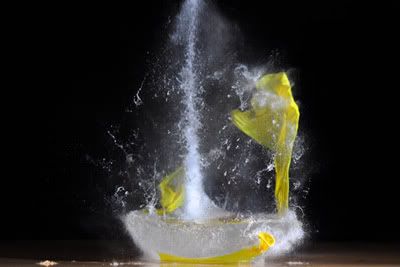In the beginners flash info post it was mentioned that the newer flash modes make automatic adjustments for how well the ambient lighting is exposed .
When shooting indoors though , the general response of auto flash modes is to try to take over total exposure of the scene at any speeds below 1/60th sec . [ This depends on the model of camera and where you have set the lowest flash speed , also the newer cameras are starting to behave differently when auto-iso is turned on] .
On to the 'tutorial' , I feel that people learn more by trying things themselves so it would be a good idea for all beginners to take a series of images indoors using flash at varying shutter speeds [ at one particular iso and aperture setting ] to see the difference it makes in the ambient lighting .
First set up a subject [ prettier than mine hopefully !] and take some images at different shutter speeds without flash .
Take note of the different colours of the light source[s] . In this image we have one green tinted light and one yellow tinted light adding to the scene .
I chose iso 800 with this large room to help the flash a bit , F5.6 let in enough light and gave enough depth of field for the situation .
As we increase the shutter speed obviously the lights get dimmer . 1/60th has fixed the 'blown out' aspect of the two lights while still retaining the colourful glow of the two different coloured light sources .
At 1/200th the room loses its glow and things start to look a little 'cold' ....
Now we turn on the flash , direct flash in this case [ for no particular reason ]....
So at 1/200th the flash lights up the room nicely but the ambient lighting doesn't look too healthy .
In the above picture the room is well enough lit but has lost the character of the yellow-cast light on the distant wall so we drop the shutter speed back to 1/60th and try again ....
Now the image has warmed up a bit , there is more of the yellow lighting on the far wall though the white light of the flash has slightly washed it out so we drop the shutter speed to 1/40th to allow more of the ambient to soak into the scene - changing the shutter speed makes no difference to the flash , it stays the same , only the ambient changes .
When taking pictures indoors there is less need to worry about the shutter speed going too low , within reason of course . Full power flash fires at about 1/700th second and as it gets weaker it fires faster , 1/16th power fires at about 1/10 000th second - this is what freezes the action and a little camera shake will only cause a slight blur in the ambient lighting only which is so weak in this situation that it is unlikely to be noticed in most images .
I have seen some good indoor shots taken hand-held at 1/6th second
and they look good because the flash is the main light source and freezes most of the motion .
Once again I will mention that it is best to set your camera up on a tripod [ to maintain the same scene ] and take a series of images , perhaps at the same settings I have chosen if you are unsure of your settings , and take note of the ambient lighting in the scene , with and without flash .
That is the best way to learn and understand what is going on in this situation before attempting it in a real life scene where you are under pressure . Since indoor lighting doesn't vary that much in different locations you will find that the settings won't vary much , besides intentional low-light settings like dance floors .
Nikon SB800
Subscribe to:
Post Comments (Atom)











These are actually wonderful ideas in about
ReplyDeleteblogging. You have touched some pleasant points
here. Any way keep up wrinting.
IDM
Easeus Data Recovery
Windows 7 activator
4k video downloader
Microsoft office 365
Windows 10 activator
xforce keygen